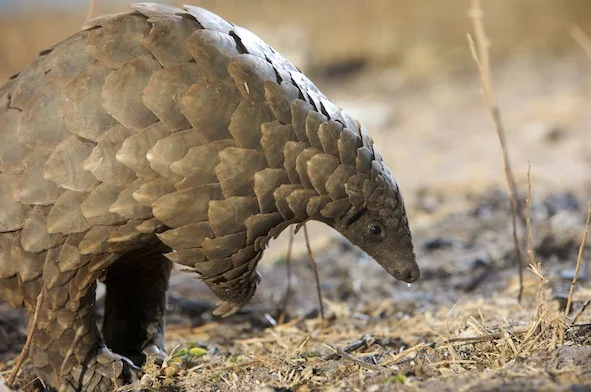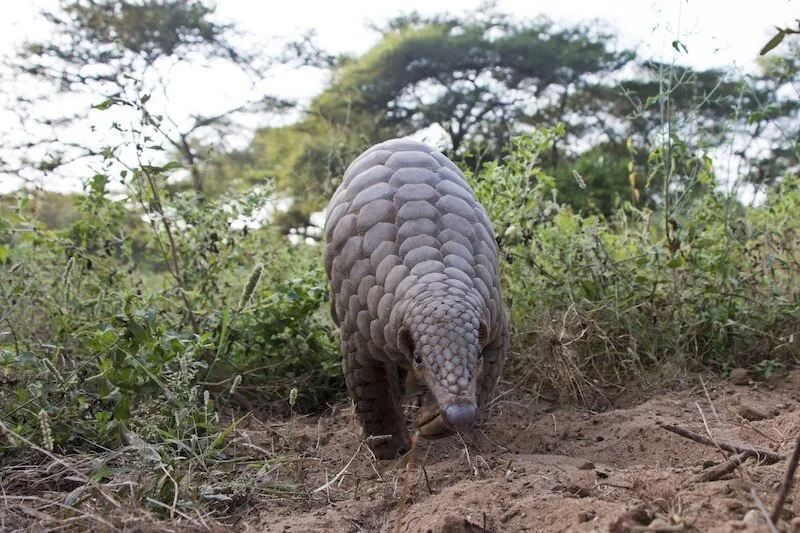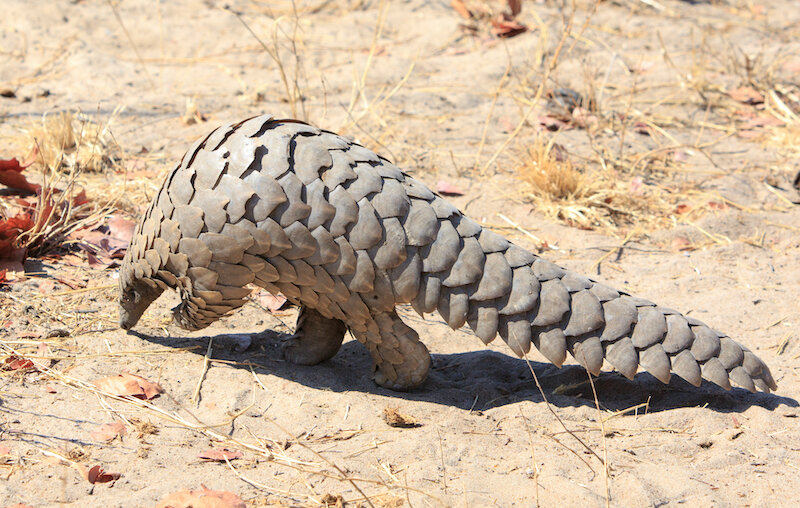Pangolins are covered in big, thick scales.
They have tails.
A pangolin eats ants.
Ants stick to its long sticky tongue so it can suck them up.
Pangolins roll up into a ball to be safe.
They are very rare animals.
What is a pangolin?
Pangolins are mammals covered in tough, overlapping scales. They are the only mammals with scales. These strange scaly mammals are one of the most endangered animal groups in the world. They are not well known, and are not seen in zoos partly because of the difficulty of sourcing millions of ants each week.
Some climb trees, some swim long distances, some dig long (as long as 40 metres) tunnels.
An African pangolin. ©Getty Images
There are eight different kinds of pangolin, four in the warmer parts of Asia (the Chinese pangolin, Malayan pangolin, Indian pangolin, Philippine pangolin) and four in Africa (the Cape or ground pangolin, white-bellied or tree pangolin, giant ground pangolin, long-tailed pangolin) .
Habitat and distribution (where are they found?)
The Asian pangolins are found in Thailand, The Philippines, Borneo, Java, Sumatra, Myanmar (Burma), Cambodia, Laos and Vietnam as well as Malaysia.
The African pangolins: two kinds live in trees and two live on the ground. The Cape or ground pangolin is found in parts of east and south Africa. The giant pangolin is found in Uganda, Tanzania and western Kenya, in grasslands, rainforests and forests but not high in the mountains. These are the biggest pangolins and live mostly on the ground. The two smallest pangolins are also African, and live in trees in rainforests.
Pangolins are found in different habitats, such as tropical forests, cleared areas, grasslands, thick bush: wherever there are ants and termites.
Body and Diet
An Asian pangolin climbing in bamboo, using its tail to hang on. ©Getty Images
Most pangolins are less than one metre long, but the giant pangolin is about one and a half metres long. The smallest of all is the black-bellied or long-tailed pangolin, about 80cm long including tail.
A pangolin's back and tail are covered with large, overlapping, horny scales. The scales are made of keratin, which is what human hair and nails are made of. Its belly and chest are covered with soft hair. It has small eyes and hidden ears. Some kinds of pangolin have a tail that is longer than their body. Their tails are prehensile, meaning they can grab hold of branches.
An Indian pangolin. ©Getty
Their diet is exclusively ants: they can consume around 70 million a year. Pangolins have a pointed snout with a small toothless mouth at the end. A long, thin, sticky tongue is used to catch termites and ants, and to drink. The ants and termites stick to the tongue and are taken into the mouth and swallowed. They are crushed by the walls of the stomach and by small pebbles that the pangolin has swallowed. At the end of its short legs, a pangolin has clawed toes that it uses for digging open ant and termite nests.
When threatened, pangolins curl up. ©Getty Images
Behaviours
All pangolins are nocturnal, which means they are active at night. They rest during the day among the leaves in the fork of a tree or in a burrow in the ground, often in a termite mound.
As they are shy animals, as well as nocturnal, not much is known about pangolins.
The Asian pangolins climb trees and hang from branches by their tail. They are very agile on the ground. The Chinese and Malayan pangolins spend the winter months in burrows. Both Cape and giant pangolins spend more time on the ground, although they can climb trees.
The pangolin can roll itself into a tight, armoured ball when hiding from predators. The name 'pangolin' is from the Malay word peng-goling, which means 'one who curls up'. Their scales are almost impossible for a predator to bite through. When threatened, pangolins can extend their scales, which have very sharp edges. They lash their tails in defence, which can cause serious gashes in an attacker. If attacked, some kinds of pangolin can spray a bad-smelling liquid like a skunk does.
An African pangolin.©Getty
Life Cycle
Female pangolins give birth to a single young each year. Pangolin young are called pangopups! The young pangopup rides on its mother's tail or back and is protected from danger by being rolled up in her tail when she sleeps.
A pangolin has small eyes and hidden ears. ©Getty
Conservation status and Threats
According to the IUCN Red List of Endangered Species, the numbers of all pangolin species are decreasing. The classifications are:
Chinese pangolin: Endangered
Malayan pangolin: Endangered.
Indian or thick-tailed pangolin: Near Threatened
Philippine or Palawan pangolin: Near Threatened
tree or African white-bellied pangolin: Near Threatened
giant ground pangolin: Near Threatened
Cape pangolin: Least Concern
long-tailed or black-bellied pangolin: Least Concern
The main danger to pangolins is from humans. They have been hunted by people for their skin for leather, their scales for traditional medicines and bodies for meat for hundreds of years. Forest clearing causing habitat loss is now an added threat.
Go here to find out more about pangolins
Watch a video of an African pangolin feasting on termites
Explore educational games on mammals at NeoK12







